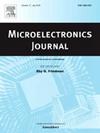基于mofts的4.5 mW 58.7 dB SNDR离散时间δ - σ调制器用于心电信号记录
IF 1.9
3区 工程技术
Q3 ENGINEERING, ELECTRICAL & ELECTRONIC
引用次数: 0
摘要
在这项研究中,我们提出了一种使用单极金属氧化物薄膜晶体管(motft)制造的一阶离散时间(DT)同步delta-sigma调制器(DSM)。介绍了一种共电流源(CCS)正反馈(PF)放大器,其中主、辅放大器共用一个尾电流源。积分器和比较器都是基于CCS架构实现的。积分器是一个三级放大器,而比较器是由两个级联的CCS与一个D触发器组成。实验结果表明,在30 Hz带宽下,DSM的信噪比和失真比(SNDR)达到58.7 dB。该DSM消耗的功率为4.5 mW,其性能值(FoM)为106 nJ/c.s。,明显优于其他基于tft的dsm。此外,该DSM成功地以高保真度捕获和处理心电信号,表明其在健康监测和TFT传感器应用中的潜力。本文章由计算机程序翻译,如有差异,请以英文原文为准。
A 4.5 mW 58.7 dB SNDR discrete-time delta–sigma modulator based on MOTFTs for ECG signal recording
In this study, we propose a first-order discrete-time (DT) synchronous delta–sigma modulator (DSM) fabricated using unipolar metal-oxide thin-film transistors (MOTFTs). A common current source (CCS) positive-feedback (PF) amplifier is introduced, in which the main and auxiliary amplifiers share a single tail current source. Both the integrator and the comparator are implemented based on the CCS architecture. The integrator is a three-stage amplifier, while the comparator is formed by cascading two stages of CCS with a D flip-flop. Experimental results show that the DSM achieves a signal to noise and distortion ratio (SNDR) of 58.7 dB at a bandwidth of 30 Hz. This DSM consumes a power of 4.5 mW, and its figure of merit (FoM) is 106 nJ/c.s., significantly superior to other TFT-based DSMs. Moreover, this DSM successfully captures and processes ECG signals with high fidelity, indicating its potential in health monitoring and TFT sensor applications.
求助全文
通过发布文献求助,成功后即可免费获取论文全文。
去求助
来源期刊

Microelectronics Journal
工程技术-工程:电子与电气
CiteScore
4.00
自引率
27.30%
发文量
222
审稿时长
43 days
期刊介绍:
Published since 1969, the Microelectronics Journal is an international forum for the dissemination of research and applications of microelectronic systems, circuits, and emerging technologies. Papers published in the Microelectronics Journal have undergone peer review to ensure originality, relevance, and timeliness. The journal thus provides a worldwide, regular, and comprehensive update on microelectronic circuits and systems.
The Microelectronics Journal invites papers describing significant research and applications in all of the areas listed below. Comprehensive review/survey papers covering recent developments will also be considered. The Microelectronics Journal covers circuits and systems. This topic includes but is not limited to: Analog, digital, mixed, and RF circuits and related design methodologies; Logic, architectural, and system level synthesis; Testing, design for testability, built-in self-test; Area, power, and thermal analysis and design; Mixed-domain simulation and design; Embedded systems; Non-von Neumann computing and related technologies and circuits; Design and test of high complexity systems integration; SoC, NoC, SIP, and NIP design and test; 3-D integration design and analysis; Emerging device technologies and circuits, such as FinFETs, SETs, spintronics, SFQ, MTJ, etc.
Application aspects such as signal and image processing including circuits for cryptography, sensors, and actuators including sensor networks, reliability and quality issues, and economic models are also welcome.
 求助内容:
求助内容: 应助结果提醒方式:
应助结果提醒方式:


